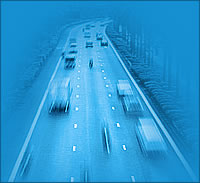Highway Rescue Project

This is a community welfare project where Nahak has provided the concept and the working model and handed it over to the able agency / institution who have successfully implemented it for the benefit of mankind. Background
The National Highway No. 8 between Ahmedabad to Bombay passing through Gujarat is one of the busiest roads in the country - a total of 263 kilometres; in fact it rates highest along with the roads that connect Bombay to Pune and Delhi to Chandigarh and Calcutta to Haldia in terms of traffic movement. For most of its distance, this stretch of NH 8 is just two lanes and very curvaceous - two factors that lead to their high number of accidents. Efforts have been made on and off to ensure that victims of accidents on this stretch of NH 8 are provided immediate succor. The Govt. Of Gujarat for years, had been kept busy in more than 100 accidents per month. This just goes to show the magnitude of the problem motorist face on the highway. Unfortunately, despite the best efforts of everyone, fatality amongst accident victims did not reduce as expected. That is where we intend to step in with a difference. We realize the bottlenecks in reaching medical care to victims and set about correcting them. The guiding principles were : Golden Hour :
Majority of deaths in road accidents can be prevented if adequate medical aid is provided to the injured within the first one hour of the accident. According to the guidelines of the Acute Trauma Life Support Service prevalent in the United Kingdom, care given within the first hour following the accident can make a difference of 80% in the chances of survival. Following this simple guideline many countries have reshaped their trauma services to take care of road accident victims. Networking :
One of the biggest bottlenecks was creating awareness amongst small and big Hospitals along the Highway about the necessity of a network of hospitals and medical centers whereby victims can reach and be provided immediate care without wastage of time. Admissions procedures in such cases in all such hospitals were simplified. Co-ordinated Approach :
The toughest job was to co-ordinate the already existing infrastructure of the state highway police, the govt. machinery and the ambulance providers. After deliberations with various authorities for over two years, permission from National Highway Authority to launch this project was secured. Tie-ups with ambulance providers and their role in traffic accident aid have been assessed and documented. Similarly State Traffic Branch were convinced to upgrade their infrastructure and train their staff. The Infrastructure and Working Pattern :
Rescue cabins were installed every 50 kilometres in this 265 kilometre stretch of NH 8. Each cabin had attendants posted round the clock and was provided with a medical van equipped with first aid kit. The five traffic aid post run by the State Highway Police on this stretch are equipped with.
and is manned by 5 police personnel and one driver. A Control Room was setup at Baroda (center of present area of operation) with facilities to reach any of these ambulance providers, respective police controls, traffic aid posts and network hospitals. Round the clock telephone helpline was set up at the control room. Methodology :
Following indicates the process of communication and pick up of victims and delivering them to the nearest medical center is as under ACCIDENT SITE calling ------- > CONTROL ROOM informing nearest ------- > RESCUE STATION ------- > AMBULANCE & TEAM are immediately sent to pickup the patient and take them to the nearest HOSPITAL Creating Awareness
The last and most crucial link in this chain was creating an awareness amongst the local masses living in towns and villages along this stretch of the NH 8. This was initiated as follows :
|
